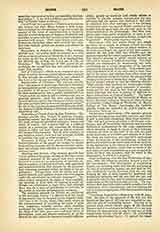

Magnus, OLAUS, Swedish historian and geographer, b. at Skeninge, Sweden, 1490; d. at Rome, August 1, 1558. He belonged to the old and noble family of Store (i.e. great, magnus), and pursued his studies from 1510 to 1517 in Germany. He was then, like his brother John Magnus, taken into the higher ecclesiastical service, and made cathedral provost at Strengnas. In 1523 King Gustave I named John Archbishop of Upsala, and sent Olaus to the pope to have the appointment confirmed. After vain efforts to prevent the king from introducing the new doctrines into Sweden, John went to Rome in 1537, and Olaus accompanied him as secretary, having by his fidelity to Catholicism lost his property in the confiscation of church goods. When John died in 1544, Olaus was appointed his successor in Upsala, but never entered into office, spending the rest of his life in Italy, for the most part in Rome. From 1545 to 1549 he attended the Council of Trent, having been commissioned to that duty by Paul III. He was buried by the side of his brother in St. Peter’s.
His works, which mark him as one of the most important geographers of the Renaissance period, were published in Italy. His knowledge of the North, which was so extensive that he was the first to suggest the idea of a northeast passage, enabled him to produce after years of labor a great map of the lands in the North. It appeared at Venice in 1539 with the title, “Carta marina et descriptio septentrionalium terrarum ac mirabilium rerum”, and included the area from the south coast of Greenland to the Russian coasts of the Baltic, including Iceland, the northern isles, Sweden, Norway, Denmark, and Finland. In this map we have the first general fairly definite representation of the North, surpassing every attempt contained in the Ptolemaic editions. The work was regarded for a long time as lost, and a single copy, procured in the sixteenth century and preserved in the Royal and National Library, Munich, was only found in 1886 by Oscar Brenner. The Munich University library has a rough copy done by hand. Niccold Zeno, the younger, in 1558, used the exact data given by the map to publish an account of a northern journey supposed to have been undertaken by his ancestors in 1400. This work created a sensation, and was not until some time later recognized as a fiction. Sebastian Munster, Gastaldi, and Ortelius also turned the map to good account. Olaus Magnus likewise compiled an important work dealing with history, geography, and natural history: “Historia de gentibus septentrionalibus” (Rome, 1555; Antwerp, 1558; Basle, 1567; Frankfort, 1618. Translations: German (Strasburg and Basle, 1567); Italian (Venice, 1565); English (London, 1658); Dutch (Amsterdam, 1665). It is divided into twenty-two books, and deals picturesquely and successively with the manners and customs, the commercial and political life of northern nations, the physical proportions of the land and its minerals and zoology. Olaus also published a life of Catharine, daughter of the Swedish St. Bridget, “Vita Catharinae”, as well as another work, “Vita abbreviata S. Briggitae”. He edited the following works of his brother John: “Historic Gothorum Succorum libris XXIV” (Rome, 1554), and the “Historia Metropolitana, seu Episcoporum et Archiepiscoporum Upsaliensium” (Rome, 1557).
OTTO HARTIG

